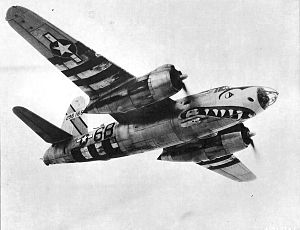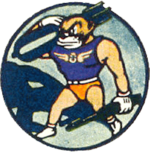| 599th Bombardment Squadron | |
|---|---|
 B-26 Marauder of the 599th Bombardment Squadron B-26 Marauder of the 599th Bombardment Squadron | |
| Active | 1943–1945 |
| Country | |
| Branch | United States Army Air Forces |
| Role | Medium bomber |
| Engagements | European Theater of Operations |
| Decorations | Distinguished Unit Citation |
| Insignia | |
| 599th Bombardment Squadron emblem |  |
| Group tail marking | Yellow diagonal stripe |
| Squadron fuselage code | 6B |
The 599th Bombardment Squadron is an inactive United States Air Force unit. It was activated at MacDill Field, Florida in April 1943. After training in the United States, it transferred to the European Theater of Operations, where it was a component of IX Bomber Command. The squadron served in combat from April 1944 until the end of World War II, earning a Distinguished Unit Citation for an attack on Ediger-Eller, Germany, in December 1944 during the Battle of the Bulge. Following V-E Day the squadron remained in France until December 1945, when it returned to the United States and was inactivated at Camp Kilmer in December 1945.
History
![]() Media related to 397th Bombardment Group (United States Army Air Forces) at Wikimedia Commons
Media related to 397th Bombardment Group (United States Army Air Forces) at Wikimedia Commons
The squadron was established at MacDill Field, Florida in April 1943 as one of the original squadrons of the 397th Bombardment Group, a Martin B-26 Marauder medium bomber group. It drew its initial cadre from the 21st Bombardment Group. The squadron trained under Third Air Force at stations in the southeastern United States. After completing its training by participating in the Tennessee Maneuvers, the squadron departed Hunter Field, Georgia for the European Theater of Operations on 12 March 1944.
The squadron was temporarily stationed at RAF Gosfield upon its arrival in England in early April 1944. On the 15th of the month, its parent group displaced the 363d Fighter Group at RAF Rivenhall and flew its first combat mission five days later. In preparation for Operation Overlord, the invasion of Normandy, the squadron participated in Operation Crossbow, attacking V-1 flying bomb launch pads. It also struck bridges, coastal defenses, marshalling yards and airfields in northern France. On D-Day the squadron attacked strong points and bombed fuel dumps and other objectives to support ground forces throughout the Normandy Campaign.
In July 1944, the squadron participated in Operation Cobra, attacking German forces near Saint Lo, France during the Allied breakout there. In August, the squadron moved from England to Gorges Airfield, an Advanced Landing Ground in France. From there it attacked naval targets at Saint Malo and Brest. Once on the Continent, the squadron made frequent moves forward as the Allied forces advanced during the Northern France Campaign. By September the squadron began flying missions into Germany, attacking depots and defended areas.
During the Battle of the Bulge, the squadron struck enemy lines of communications. On 23 December 1944 the unit severed a railway bridge at Ediger-Eller, Germany, despite heavy flak and fighter opposition from the Luftwaffe. For this action it was awarded a Distinguished Unit Citation. The squadron continued to fly missions to support the Allied drive into Germany until 20 April 1945, exactly one year after its first combat mission, having completed 239 combat missions.
After V-E Day the squadron returned to its former base at Peronne Airfield, France, and remained there until December, when it returned to the United States. Upon arrival at Camp Kilmer, New Jersey in late December, the squadron was inactivated.
Lineage
- Constituted as the 599th Bombardment Squadron (Medium) on 20 March 1943
- Activated on 20 April 1943
- Redesignated 599th Bombardment Squadron, Medium c. April 1944
- Inactivated on 22 December 1945
Assignments
- 397th Bombardment Group, 20 April 1943 – 22 December 1945
Stations
- MacDill Field, Florida, 20 April 1943
- Avon Park Army Air Field, Florida, 14 October 1943
- Hunter Field, Georgia, 1 November 1943 – 12 March 1944
- RAF Gosfield (Station 154), England, 5 April 1944
- RAF Rivenhall (Station 168), England, 15 April 1944
- RAF Hurn (AAF-492), England, 5 August 1944
- Gorges Airfield (A-26), France, c. 31 August 1944
- Dreux/Vernouillet Airfield (A-41), France, c. 16 September 1944
- Peronne Airfield (A-72), France, c. 7 October 1944
- Venlo Airfield (Y-55), Netherlands, 25 April 1945
- Peronne Airfield (A-72), France, 30 May – c. December 1945
- Camp Kilmer, New Jersey, 21–22 December 1945
Aircraft
- Martin B-26 Marauder, 1943–1945
Awards and campaigns
| Award streamer | Award | Dates | Notes |
|---|---|---|---|
| Distinguished Unit Citation | 23 December 1944 Germany | 599th Bombardment Squadron |
See also
References
Notes
- Explanatory notes
- Aircraft is Martin B-26B-55-MA Marauder serial 42-96165, Big Hairy Bird, fuseage code 6B-I Taken on 1 December 1944.
- Approved 10 June 1944. Description: Over and through a light blue green disc, border black, a caricatured beaver with look of ferocity on face, having human "strong man's" body tan, wearing light red boxing trunks, white belt, and blue sleeveless jersey marked on chest with winged beaver head, and white shoes and gloves, carrying a large black aerial bomb, highlighted of the field on the right shoulder, and a black, aerial machine gun in the left hand, highlighted of the field , all casting black drop shadow to dexter.
- Citations
- ^ Maurer, Combat Squadrons, p. 679
- ^ Watkins, pp. 112–113
- ^ Maurer, Combat Units, pp. 283–284
- ^ "Abstract, History 397 bombardment Group Apr 1943 – Mar 1944". Air Force History Index. Retrieved 25 September 2015.
- "Abstract, History 397 Bombardment Group Apr–May 1944". Air Force History Index. Retrieved 25 September 2015.
- "Abstract, History 397 Bombardment Group Apr 1945". Air Force History Index. Retrieved 25 September 2015.
- ^ Station numbers in Anderson
- ^ Station numbers in Johnson
Bibliography
![]() This article incorporates public domain material from the Air Force Historical Research Agency
This article incorporates public domain material from the Air Force Historical Research Agency
- Anderson, Capt. Barry (1985). Army Air Forces Stations: A Guide to the Stations Where U.S. Army Air Forces Personnel Served in the United Kingdom During World War II (PDF). Maxwell AFB, AL: Research Division, USAF Historical Research Center. Archived from the original (PDF) on 4 March 2016. Retrieved 7 July 2012.
- Johnson, 1st Lt. David C. (1988). U.S. Army Air Forces Continental Airfields (ETO) D-Day to V-E Day (PDF). Maxwell AFB, AL: Research Division, USAF Historical Research Center. Archived from the original (PDF) on 29 September 2015.
{{cite book}}: CS1 maint: numeric names: authors list (link) - Maurer, Maurer, ed. (1983) . Air Force Combat Units of World War II (PDF) (reprint ed.). Washington, DC: Office of Air Force History. ISBN 0-912799-02-1. LCCN 61060979.
- Maurer, Maurer, ed. (1982) . Combat Squadrons of the Air Force, World War II (PDF) (reprint ed.). Washington, DC: Office of Air Force History. ISBN 0-405-12194-6. LCCN 70605402. OCLC 72556.
- Watkins, Robert (2008). Battle Colors. Vol. III Insignia and Markings of the Ninth Air Force in World War II. Atglen, PA: Shiffer Publishing Ltd. ISBN 978-0-7643-2938-8.